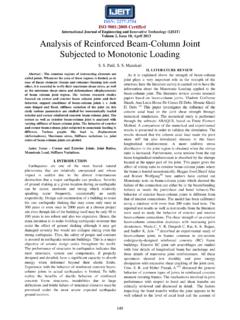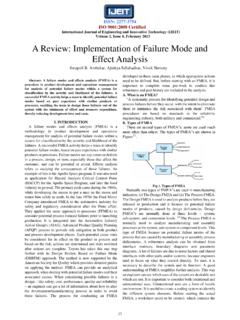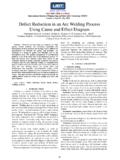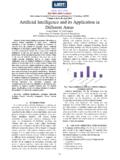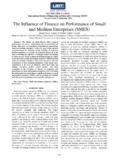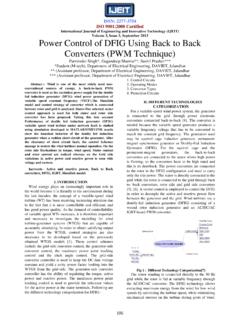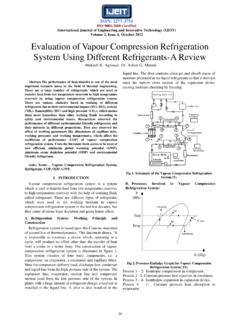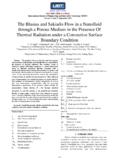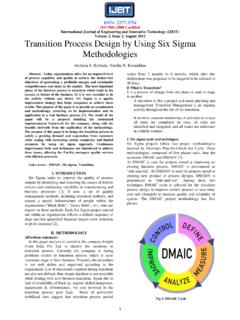Transcription of Analysis the effect Atmosphere Turbulence in Free- Space ...
1 ISSN: 2277-3754 ISO 9001:2008 Certified International Journal of Engineering and Innovative Technology (IJEIT) Volume 3, Issue 11, May 2014 301 Analysis the effect Atmosphere Turbulence in Free- Space Optical (FSO) Communication Systems 1 Amarjeet Kaur, 2 Ravinder Kumar Panchal 1 Assistant Professor, Dept. Of ECE, Satya College of Engineering and Technology, Faridabad, Haryana 2M-Tech Scholar, Satya College of Engineering and Technology, Faridabad, Haryana Abstract: Over the last two decades Free- Space optical communication (FSO) has become more and more interesting as an adjunct or alternative to radio frequency communication.
2 In this paper, performance of free Space optical (FSO) communication in the presence of atmospheric Turbulence is presented. FSO system required free line of sight between the transmitter and receiver. Light travels through air faster than it does through glass. Different factors that affect the performance of the communication channel in free Space optical communication system is presented with different channel model such as Rayleigh, Rice and Nakagami models. The performance controlling parameters are outage probability and bit error rate (BER).
3 Simulation results show the performance of different channel models with different level of channel Turbulence in FSO system. Results also show that as the signal to noise ratio increase, BER goes on decreasing and try to approaches the theoretical value. A comparison of BER is also presented with the changing value of the channel Turbulence with gamma-gamma channel model in FSO system. Index Terms: Free- Space optical communication (FSO), Nakagami-m channel model, bit error rate (BER), gamma-gamma channel model, Atmospheric Turbulence .
4 I. INTRODUCTION FSO is wireless laser-based point-to-point communications in which the points have clear line-of-sight between them. Atmospheric Turbulence has a significant impact on the quality of a laser beam propagating through the Atmosphere over long distances. In the presence of atmospheric Turbulence , the received signal exhibits random intensity fluctuations which increase the BER. Performance evaluated under considering the effects of the atmospheric turbulences which is the great challenges for the FSO.
5 Free Space optical (FSO) communications, is a cost-effective and high bandwidth access technique, which is receiving growing attention with recent commercialization application [1]. Major impairment over FSO links is the atmospheric Turbulence [2], which results in fluctuations at the received signal, severely degrading the link performance. In this paper, performance of free Space optical (FSO) communication in the presence of atmospheric Turbulence is presented. Different factors that affect the performance of the communication channel in free Space optical communication system is presented with different channel model such as Rayleigh, Rice and Nakagami models.
6 The performance controlling parameters are outage probability and bit error rate (BER). Simulation results show the performance of different channel models with different level of channel Turbulence in FSO system. FSO is now common for point-to-point communications between fixed locations on land, and is also used for communications between moving platforms on land, the surface of the sea and in air. Despite the major advantages of FSO communications, there are several challenges in a practical deployment. Aerosol scattering, caused by rain, snow and fog, leads to performance degradation [4].
7 Another possible impairment over FSO links is building-sway as a result of wind loads, thermal expansion and weak earthquakes [3]. But the major problem is that FSO links suffer from atmospheric Turbulence because of in homogeneities in the index of refraction known as scintillation, which leads to stochastic amplitude (and power) fluctuations [6][8]. This phenomenon, which is known as fading or scintillation, degrades the link performance particularly for distances of 1 km and above [6]. To overcome such limitations, both error control coding [9] [10] and multiple input multiple output techniques have been proposed for FSO systems [11]-[13].
8 The rest of the paper is organized as follows: In Section II, basic of free Space optical (FSO) communication is explained. In section III, explains the factors that affect the performance of free Space optical communication that includes scattering, absorption and atmospheric Turbulence . Section IV introduces the Nakagami-m distribution used for the Analysis of the performance of the system. In Section V, simulation results will be explained with the help of graphical representation to Analysis the affect of different level of Turbulence .
9 Section VI, conclusions will be put forward. II. FREE Space OPTICAL COMMINICATION FSO technology is relatively simple. It's based on connectivity between FSO units, each consisting of an optical transceiver with a laser transmitter and a receiver to provide full duplex (bi-directional) capability. Each FSO unit uses a high-power optical source ( laser), plus a lens that transmits light through the Atmosphere to another lens receiving the information. The receiving lens connects to a high-sensitivity receiver via optical fiber. FSO communication systems are illustrated in Fig.
10 1. A source producing data input is to be transmitted to a remote destination. This source has its output modulated ISSN: 2277-3754 ISO 9001:2008 Certified International Journal of Engineering and Innovative Technology (IJEIT) Volume 3, Issue 11, May 2014 302 onto an optical carrier; typically laser, which is then transmitted as an optic al field through the atmospheric channel [6]. The important aspects of the optical transmitter system are size, power, and beam quality, which determine laser intensity and minimum divergence obtainable from the system.
